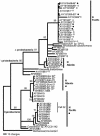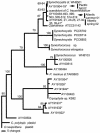N2 fixation by unicellular bacterioplankton from the Atlantic and Pacific oceans: phylogeny and in situ rates
- PMID: 14766553
- PMCID: PMC348867
- DOI: 10.1128/AEM.70.2.765-770.2004
N2 fixation by unicellular bacterioplankton from the Atlantic and Pacific oceans: phylogeny and in situ rates
Abstract
N2-fixing proteobacteria (alpha and gamma) and unicellular cyanobacteria are common in both the tropical North Atlantic and Pacific oceans. In near-surface waters proteobacterial nifH transcripts were present during both night and day while unicellular cyanobacterial nifH transcripts were present during the nighttime only, suggesting separation of N2 fixation and photosynthesis by unicellular cyanobacteria. Phylogenetic relationships among unicellular cyanobacteria from both oceans were determined after sequencing of a conserved region of 16S ribosomal DNA (rDNA) of cyanobacteria, and results showed that they clustered together, regardless of the ocean of origin. However, sequencing of nifH transcripts of unicellular cyanobacteria from both oceans showed that they clustered separately. This suggests that unicellular cyanobacteria from the tropical North Atlantic and subtropical North Pacific share a common ancestry (16S rDNA) and that potential unicellular N2 fixers have diverged (nifH). N2 fixation rates for unicellular bacterioplankton (including small cyanobacteria) from both oceans were determined in situ according to the acetylene reduction and 15N2 protocols. The results showed that rates of fixation by bacterioplankton can be almost as high as those of fixation by the colonial N2-fixing marine cyanobacteria Trichodesmium spp. in the tropical North Atlantic but that rates are much lower in the subtropical North Pacific.
Figures




References
-
- Baker, C. S., F. Cipriano, and S. R. Palumbi. 1996. Molecular genetic identification of whale and dolphin products from commercial markets in Korea and Japan. Mol. Ecol. 5:671-685.
-
- Bergman, B., J. R. Gallon, A. N. Rai, and L. J. Stal. 1997. N2 fixation by non-heterocystous cyanobacteria. FEMS Microbiol. Rev. 19:139-185.
-
- Berman-Frank, I., P. Lundgren, Y. Chen, H. Küpper, Z. Kolber, B. Bergman, and P. Falkowski. 2001. Segregation of nitrogen fixation and oxygenic photosynthesis in the marine cyanobacterium Trichodesmium. Science 294:1534-1537. - PubMed
-
- Berman-Frank, I., J. T. Cullen, Y. Shaked, R. M. Sherrell, and P. G. Falkowski. 2001. Iron availability, cellular iron quotas, and nitrogen fixation in Trichodesmium. Limnol. Oceanogr. 46:1249-1260.
-
- Brand, L. E. 1991. Minimum iron requirements of marine phytoplankton and the implications for the biogeochemical control of new production. Limnol. Oceanogr. 36:1756-1771.
Publication types
MeSH terms
Substances
Associated data
- Actions
- Actions
- Actions
- Actions
- Actions
- Actions
- Actions
- Actions
- Actions
- Actions
- Actions
- Actions
- Actions
- Actions
- Actions
- Actions
- Actions
- Actions
- Actions
- Actions
- Actions
- Actions
- Actions
- Actions
- Actions
- Actions
- Actions
- Actions
- Actions
- Actions
- Actions
- Actions
- Actions
- Actions
- Actions
- Actions
- Actions
- Actions
- Actions
- Actions
LinkOut - more resources
Full Text Sources
Molecular Biology Databases
Miscellaneous

